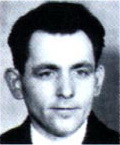The date is 8 November 1939, the location – the Bürgerbräukeller beer hall in Munich. With their uniforms freshly pressed, their buttons gleaming, their shoes polished, Hitler’s longest-standing comrades filed into the hall, their chests puffed up with pride, their wives at their sides. This event, on this day, had become an annual occasion in the Nazi calendar, a ritual of celebration and remembrance. The climax of the evening, awaited with great anticipation, would be Hitler’s appearance and his speech in which he would praise and pour tribute on these self-satisfied men, his old-timers.
But there was one man who awaited Hitler’s appearance with equal anticipation – but for entirely different reasons. This man was a 36-year-old carpenter, Johann Georg Elser, born 4 January 1903. For Elser, a long-time anti-Nazi, had planted a bomb with the full intention of killing Adolf Hitler. And his bomb was due to explode halfway through the Fuhrer’s speech.
Kill Hitler
 Georg Elser had always been quietly defiant in his hatred of the Nazi regime – he’d supported the communists and, once Hitler was in power, refused to give the Nazi salute. He feared Hitler’s aggressive warmongering and foresaw the coming of war and resolved himself, in his own way, to do something to prevent it – and that was to kill Hitler.
Georg Elser had always been quietly defiant in his hatred of the Nazi regime – he’d supported the communists and, once Hitler was in power, refused to give the Nazi salute. He feared Hitler’s aggressive warmongering and foresaw the coming of war and resolved himself, in his own way, to do something to prevent it – and that was to kill Hitler.
Exactly a year earlier before the fateful night, on the 8 November 1938, Elser attended the same annual commemoration in Munich marking the anniversary of Hitler’s failed Beer Hall Putsch of 1923. And it was this annual event, he decided, that would provide the perfect opportunity to implement his audacious plan. The following night, he witnessed first-hand the vicious Kristallnacht, when Nazis throughout the country terrorized Germany’s Jews in a concentrated orgy of killing and violence. Seeing for himself this state-sponsored anarchy merely confirmed for Elser that what he was doing was right.
Elser spent the next year preparing. Each year on 8 November, since 1933, Hitler had come to the same beer hall and delivered a two-hour speech, starting at 8.30, the precise time that, in 1923, he had bulldozed into the hall brandishing a pistol, interrupting a meeting of Bavarian city officials and, firing two shots into the ceiling, declared revolution. The Beer Hall Putsch failed but had become an occasion to honour and remember the Nazis that had fallen that night in Munich.
Thus Elser, who managed to secure a job as a carpenter within the beer hall, painstakingly hollowed out a pillar near the speakers’ podium and placed within it a timed device set to go off at the point Hitler was midway through his speech.
Thirteen minutes
 But sadly for Elser (pictured), and indeed for all mankind, Hitler changed his routine. War had broken out two months before and Hitler had more pressing matters to attend to and had to get back to Berlin. Thus, Hitler began his speech earlier than normal and instead of the usual two hours, spoke only for an hour. He left the building at 9.07. Thirteen minutes later, Elser’s bomb went off. It killed eight Nazis and injured over sixty. But Hitler was not one of them.
But sadly for Elser (pictured), and indeed for all mankind, Hitler changed his routine. War had broken out two months before and Hitler had more pressing matters to attend to and had to get back to Berlin. Thus, Hitler began his speech earlier than normal and instead of the usual two hours, spoke only for an hour. He left the building at 9.07. Thirteen minutes later, Elser’s bomb went off. It killed eight Nazis and injured over sixty. But Hitler was not one of them.
Elser was arrested as he tried to escape into Switzerland. He was interrogated and brutally tortured by the Gestapo, often in the presence of Heinrich Himmler, who refused to believe that Elser had worked alone and was not part of a wider conspiracy. Astonishingly, they didn’t execute him – at least not straight away. They kept him alive until the very end… he was shot in Dachau concentration camp on 9 April 1945, weeks before its liberation.
Thirteen Minutes is the name of a 2015 film about Elser and his failed assassination.
Hellmut G Haasis’s book, Bombing Hitler: The Story of the Man Who Almost Assassinated the Führer, originally published in German in 2001, has only just been released in English. Piecing together contemporary transcripts, personal testimonies and family recollections, Haasis puts together a compelling story of the doomed hero, a testament to a man who almost singlehandedly changed the course of twentieth-century history – almost. It is a story of quiet courage, determination and tragedy. One closes the book wondering what might have been had this simple carpenter with a mission had set his bomb to go off just thirteen minutes earlier.
By such thin threads, hangs the destiny of mankind.
 Rupert Colley.
Rupert Colley.
Read more in The Clever Teens’ Guide to Nazi Germany, available as ebook and paperback (80 pages) on Amazon, Barnes & Noble, Waterstone’s, Apple Books and other stores.